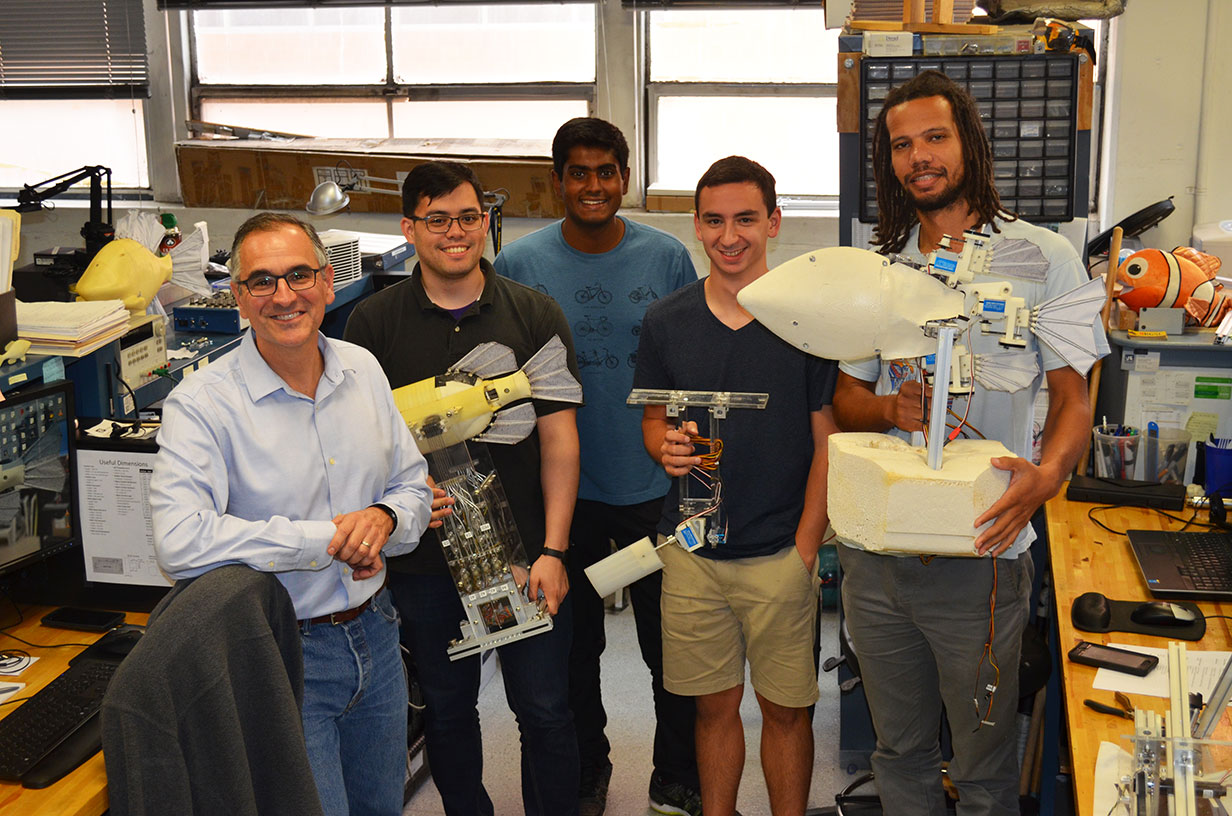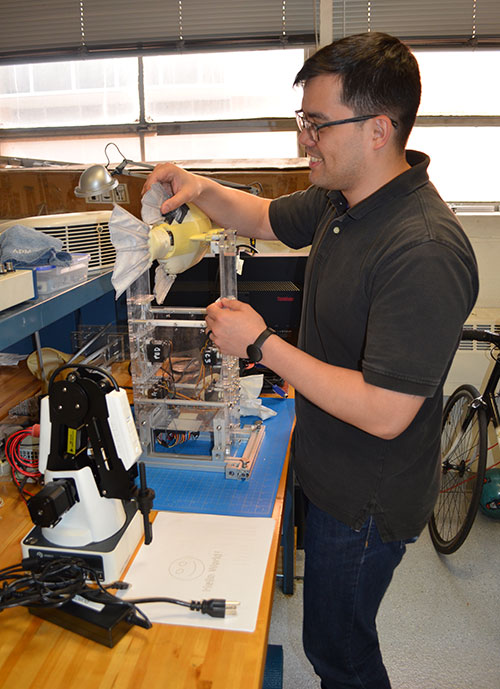PhD candidate Anthony Mignano holds up his model of a Bluegill pectoral fin built out of a polyester/Lycra blend fabric and pulled over rigid plastic rays, like a glove. When he switches the model on, the fin waves and bends with a motion both mesmerizing and familiar. Everyone knows what a moving fin looks like. What’s less clear is the “how” of it – the complex interplay of neural control and mechanics that enables a creature to move smoothly through the water.
It’s a system humans would very much like to engineer.
With a recent $1.4M collaborative grant from the Office of Naval Research (ONR), Dr. James Tangorra, associate professor in the Department of Mechanical Engineering and Mechanics (MEM), and PhD students like Mignano are doing just that. They are learning how to swim; or more precisely, learning the principles of control systems, kinematics, and hydromechanics of fins during complex “gaits” and maneuvers.

Dr. James Tangorra and members of his Laboratory for Biological Systems Analysis
Tangorra’s research focuses on advancing designs for integrated underwater systems that move as well as an animal, or at least leverage the efficiency with which animals move. Fin- and flippered-animals don’t simply lurch forward. They also yaw, pitch, roll, swim quickly, swim slowly, surf, dive, or just loll about. They swim in turbulent littoral zones, they mate in calm waters, they migrate upriver or swim in the open ocean. Some locomote onto land.
The lessons distilled from studying their varied movements in conjunction with, for example, the vortices created by sea lion flippers or how otters sense pressure differentials, are used to design highly maneuverable underwater vehicles and the core systems that support them. The ONR’s Maritime Sensing Program uses research like Tangorra’s to develop devices that are part of on-board equipment for Navy surface ships, submarines, autonomous vehicles, and other machines deployed in what it calls the “undersea battle space.”
“If we understand the underlying phenomena that animals take advantage of, we might be able to adapt that to something we can engineer,” said Tangorra. “What you want to get from the sunfish or sea lion or otter might not directly mimic what the animal is doing, but you might understand the better way that they’re doing it.
“For instance, sea lions are very maneuverable, but not exclusively because of their flippers,” added Tangorra. “They’re maneuverable because of the way their flippers sit on their body and the flexibility they have in their bodies. They’re not just swimming, they’re turning in the field of water. They have mechano-sensors and proprioceptors and many different sensing mechanisms that work well in the underwater environment. That’s what we’re looking at.”
Asked how our vehicles compare in maneuverability to the average sea lion, Tangorra answered, “We’re not as good as your average sea lion.”
Building the Prototypes
Mignano builds many of the biorobotic models for Tangorra’s Laboratory for Biological Systems Analysis. He developed “PDAC,” which stands for Peduncle, Dorsal, Anal and Caudal fins, after repeatedly watching a video of a sunfish swimming in a flow tank. The video was supplied by renowned biologist George Lauder of Harvard University, a collaborator, along with the University of Chicago, on the ONR grant.
“When I was designing this model,” said Mignano, “I kept asking myself, what are the minimum number of fin rays I need in order to get the shape I want? How does a fin move under different conditions? Which muscles are being activated? They all influence my design. We broke it all down mathematically to see what the predominant motions are within the fin and the expected force you would get from each of those predominant motions. That was used to design this robot. It mimics those movements.”

Anthony Mignano with a Bluegill sunfish model
When placed in a tank of fresh water that sat nearby, the model generated a variety of patterns and data that are then analyzed through computer software to determine exactly what is going on in these biological systems. Tangorra is essentially looking for the most productive factors for a specific task. The PDAC’s pectoral fin can produce an interesting force profile, for example; it’s 100% thrust. If researchers start playing with the parameters contributing to that profile, then they will begin to understand how to reproduce those outcomes in a machine.
“It’s very different from a biological system,” said Tangorra. “We really have to adapt what the animal is doing to the framework of an engineered system. There’s a translation there: what are the principles that are being used and how can you take advantage of them?
“We realize that the way the body flexes and rotates, for instance, is important to create preferential hydrodynamic forces. It’s a coordinated motion that creates an agile motion. They’re pushing against the fluid that is surrounding their whole body to create forces underwater.”
Lauder, a long-time collaborator, credited the Lab for its contributions to the field.
“The Tangorra lab has developed the technology to incorporate multiple fin rays into a robotic fin, and to control these in a biologically realistic manner,” said Lauder. “These robotic fins are quite flexible and the changing surface conformation through time allows fish-like swimming performance. This is a substantial accomplishment and a real advance over previous attempts to model fish fins, and has allowed the development of aquatic propulsors that represent the next generation of underwater robotic systems.”
Think Like a Fish
The neural circuitry behind fish movement and how feedback from the body plays into its efficiency is fundamental to the research, as well. Understanding the biological structure could provide important clues to developing “biologically evolved circuits” in underwater vehicles. That’s where PhD candidate Gabe Carryon comes into the picture. He has been with Tangorra’s lab for over six years.
“People have devoted their entire lives to trying to understand these circuits,” said Carryon. “We are taking it from a very basic level: how do you get a circuit to move a fin back and forth? We use a very simplified mathematical model of this complex circuit. Well, ‘simplified’ compared to what the actual biology is.”

Gabe Carryon analyzing neural circuitry
The circuits respond to sensory feedback—depth or pressure, or how water is moving past the body—in an adaptive response that is effective and economical. Sometimes, Carryon looks at the fin tip to see how it is behaving. Alternatively, he analyzes the fin rays that separate the fin membrane into lengthwise segments. They can, and do, move independent of one another to produce a variety of motions.
Tangorra, whose early research explored artificial muscle material and conductive polymers, has been at this game for 12 years. The research has received five ONR grants, he said, and continues to bear fruit. Among the results are everything from determining how individual fins can be tuned to produce “good” forces, to engineering neural circuits for control, to understanding how motions from the fins and body can be orchestrated to create 3D swimming.
There are tens of thousands of species of fish that have found different solutions to the problem of swimming, Tangorra said. Studying those exhibited by just a few fin and flipper animals yields a trove of information on how humans can design better underwater systems and machines.
“Fish have been around a lot longer than we have,” he added. “We’re just trying to figure out how they do it.”